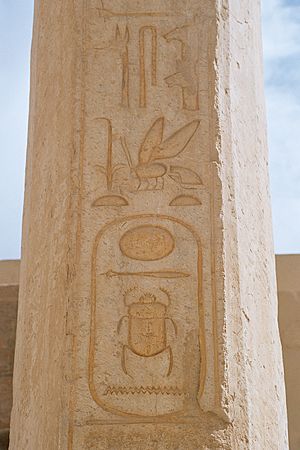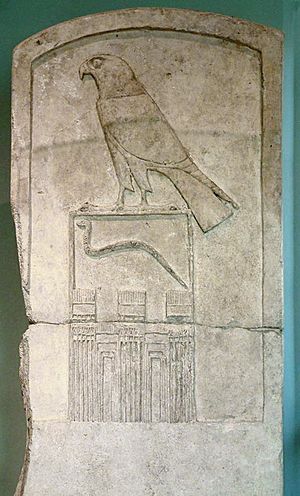Ancient Egyptian royal titulary facts for kids
The royal titulary is like the official full name and set of titles used by the pharaohs of ancient Egypt. It showed their power in the world and their connection to the gods. It also acted like a special statement about what they planned to do during their time as ruler.
This full set of five names became standard during the Middle Kingdom. It was used for a very long time, even up to the time of the Roman Empire.
Contents
How the Names Started
Pharaohs were seen as divine, meaning they were like gods on Earth. To connect them to both people and gods, special titles were made when they became pharaoh. These titles also showed their good qualities and linked them to the land of Egypt.
The five names developed over many centuries:
- The Horus name was the first. It showed the pharaoh as a representative of the god Horus.
- The Nebty name came next. It put the king under the protection of two goddesses, Nekhbet (from Upper Egypt) and Wadjet (from Lower Egypt).
- The Gold Falcon name (or Horus of Gold) appeared later, around the Fourth Dynasty of Egypt.
- The last two names, the prenomen (Throne name) and the nomen (Personal name), were usually written inside a special oval shape called a cartouche. Eventually, all royal names, including those of queens and royal children, were placed in cartouches.
Horus Name
𓅃𓊁
The Horus name is the oldest part of a pharaoh's name. It started even before ancient Egypt became a unified country. Many of the earliest pharaohs are known only by this name.
The Horus name was usually written inside a serekh. A serekh was a drawing that looked like the front of a palace. The pharaoh's name was written in hieroglyphs inside this palace drawing. Usually, a picture of the falcon god Horus sat on top of or next to it.
One pharaoh, Seth-Peribsen from the Second Dynasty of Egypt, used a picture of the god Set instead of Horus. This might show a religious difference in the country at that time. His successor, Khasekhemwy, used symbols for both Set and Horus above his name. After that, the image of Horus always appeared with the pharaoh's name.
By the time of the New Kingdom, the Horus name was often written without the serekh around it.
Nebty ("Two Ladies") Name
|
|
The Nebty name means "two ladies." It was connected to the two main goddesses of Upper and Lower Egypt:
- Nekhbet, the protector goddess of Upper Egypt, shown as a vulture.
- Wadjet, the protector goddess of Lower Egypt, shown as a cobra.
This name was first clearly used by pharaoh Semerkhet from the First Dynasty of Egypt. However, it became a fully independent title only by the Twelfth Dynasty.
This name was not usually put inside a cartouche or serekh. It always started with the hieroglyphs of a vulture and a cobra sitting on two baskets. These baskets represent the word "nebty."
Horus of Gold
|
|
This name is also called the Golden Horus name. It usually showed a Horus falcon sitting above or next to the hieroglyph for gold.
The exact meaning of this title has been debated. One idea is that it shows Horus winning over his uncle Set. The symbol for gold might mean that Horus was "better than his enemies." Gold was also strongly linked to eternity in ancient Egypt. So, this name might have meant the pharaoh's Horus name would last forever.
Like the Nebty name, this name was usually not put inside a cartouche or serekh.
Throne Name (Prenomen)

|
|
The pharaoh's throne name was the first of the two names written inside a cartouche. It usually came with the title nsw-bity. This title is often translated as "King of Upper and Lower Egypt." The sedge plant and the bee symbols were thought to represent Upper and Lower Egypt.
Another common phrase used with this name was nb tꜣwy, meaning "Lord of the Two Lands." This referred to the valley and delta regions of Egypt.
Personal Name (Nomen)
|
This was the name a pharaoh was given at birth. Before this name, there was usually the title "Son of Ra." This was written with the hieroglyph of a duck (za), which sounded like the word for "son" (za). Next to it was an image of the sun, which was the hieroglyph for the main sun god, Ra.
This name was added to the royal titles in the Fourth Dynasty. It showed the king's role as a representative of the sun god Ra. For women who became pharaoh, the title was understood to mean "daughter" of Ra.
Today, historians usually refer to ancient Egyptian kings by this birth name. They add numbers like "II" or "III" to tell apart different pharaohs with the same name.
Examples of the Full Titulary
Senusret I
In the Middle Kingdom, the full set of names was sometimes written in a single cartouche. Here is an example from Senusret I, found at Beni Hasan.
Hatshepsut
Here is the full set of names for Hatshepsut, a pharaoh from the Eighteenth Dynasty. This example also shows how the names were different because she was a woman.
- Horus name: Wesretkau, meaning "Mighty of Kas" (Kas are like life forces or spirits).
- Nebty name: Wadjrenput, meaning "She of the Two Ladies, Flourishing of years."
- Golden Horus: Netjeretkhau, meaning "Divine of appearance." Netjeret is the female form of 'godly' or 'divine'.
- Throne name (Praenomen): Maatkare, meaning "Truth [Ma'at] is the Ka of Re."
- Personal name (Nomen): Khnumt-Amun Hatshepsut, meaning "Joined with Amun, Foremost of Noble Ladies."
Thutmose III
Here is the full set of names for Thutmose III, another pharaoh from the Eighteenth Dynasty.
- Horus name: Kanakht Khaemwaset, meaning "Horus Mighty Bull, Arising in Thebes."
- Nebty name: Wahnesytmireempet, meaning "He of the Two Ladies, Enduring in kingship like Re in heaven."
- Golden Horus: Sekhempahtydjeserkhaw, meaning "Horus of Gold Powerful of strength, Sacred of appearance."
- Throne name (Praenomen): Menkheperre, meaning "He of the Sedge and the Bee, Enduring of form is Re."
- Personal name (Nomen): Thutmose Neferkheperu, meaning "Son of Ra, Thutmose, beautiful of forms."
See also
 In Spanish: Titulatura real en el Antiguo Egipto para niños
In Spanish: Titulatura real en el Antiguo Egipto para niños



